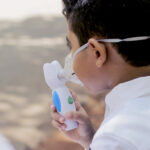Rett syndrome sees glimmer of hope in Phase I trial

Part 1 of a two-part series. (Read part 2.)
In the world of neurodevelopmental disorders, an exciting trend is the emergence of specific molecular targets and treatments through genetic research. A case in point is IGF-1 therapy for Rett syndrome, a devastating disorder in girls that affects their ability to speak, walk, eat and breathe. It causes autism-like behaviors, intellectual disability and repetitive hand-wringing movements—a hallmark of the disorder.
A Phase I trial, published this week in the Proceedings of the National Academy of Sciences Early Edition, has modest but consistent results suggesting improvements in some salient features of the disorder.
Current treatments for Rett syndrome address only the symptoms and comorbidities, such as seizures, anxiety and scoliosis, but not the disease itself. But in 2007, findings in a mouse model (which even replicated the hand-wringing) changed how scientists think about Rett and other neurodevelopmental disorders, previously thought to be untreatable. Researchers in Scotland restored the function of the gene that’s mutated in Rett syndrome, MECP2, and the mice showed a striking reversal of their neurologic symptoms.
The paper had an impact around the world. In 2010, Boston Children’s Hospital launched a clinical trial of insulin-like growth factor 1 (IGF-1), an FDA-approved human growth hormone, in girls with Rett syndrome. IGF-1, which is indirectly regulated by MECP2, has been shown to enhance the maturation and maintenance of synapses, both known to be impaired in Rett syndrome and to ameliorate several Rett-like features in mice.
The current Phase 1 study enrolled 12 girls with MECP2 mutations, including nine with a clinical diagnosis of Rett syndrome. The girls received injections of recombinant human IGF-1 (mecasermin) in increasing doses for four weeks, followed by 20 weeks of open-label treatment at the highest dose.
Ten of the girls completed both periods of treatment, receiving a total of 24 weeks of IGF-1 therapy. The drug was safe and well tolerated—the primary endpoints of the study—and pharmacokinetic studies showed increased levels of IGF-1 in patients’ cerebrospinal fluid, confirming that the medication does, in fact, reach the brain.
There were other improvements as well. Automated cardiorespiratory monitoring showed a decrease in episodes of apnea. Behavioral scales found improvement in some measures of anxiety (fear and avoidance) and mood abnormalities. Analysis of frontal asymmetry on EEG, an index of anxiety and depression, showed improvements and in some cases reversal of this EEG finding.
The study—supported by the International Rett Syndrome Foundation, Autism Speaks, Harvard Catalyst and the Translational Research Program at Boston Children’s—was designed to assess safety, not efficacy. As a result, its sample size was too small to demonstrate significant improvements in communication or motor function.
But the study’s principal investigator Walter Kaufmann, MD, director of the Rett Syndrome Program at Boston Children’s, believes the IGF-1 signaling pathway in the brain holds much promise and that there is reason for the families of children with Rett syndrome to be hopeful.
This trial, an extension of pioneer preclinical work using a mouse model, includes clinical instruments, standardized measures and novel biomarkers,” says Kaufmann. “For these reasons, we believe this work will have a major impact on the understanding and treatment of Rett syndrome as well as other neurodevelopmental disorders.”
Kaufmann and his team are now conducting a Phase 2 trial of IGF-1 that will ultimately enroll 30 girls, 2 to 10 years old, who are in the “stable” (post-regression) stage of their disease. If successful, it will be followed by a larger replication Phase 3 study.
Rett syndrome is one of several autism-related conditions for which there are targeted treatments in trials. Boston Children’s is leading a randomized trial of a drug called RAD001 in children and young adults with tuberous sclerosis complex, for example, and is part of a large multicenter trial of AFQ056 in adolescents with fragile X syndrome, sponsored by Novartis Pharmaceuticals.
Since these diseases involve behavioral symptoms, experience has shown that patients need to be classified rigorously and findings confirmed with objective measures to achieve robust results. Together, the studies provide a glimmer of hope that core disease features—not just secondary symptoms—aren’t a “done deal” but could actually be treated and even reversed.
Related Posts :
-

AI-enabled medical devices are burgeoning, but many haven’t been tested in children
Medical devices that incorporate artificial intelligence and machine learning are proliferating. In 2013, the FDA approved fewer than 10 such devices; by 2023, ...
-

A sickle cell first: Base editing, a new form of gene therapy, leaves Branden feeling ‘more than fine’
Though he doesn’t remember it, Branden Baptiste had his first sickle cell crisis at age 2. Through elementary school, he ...
-

Will early intervention prevent asthma in school-age children?
Asthma affects about 1 in 10 children, often sending them to the emergency room or causing them to miss school. Allergic conditions ...
-

First-of-its-kind clinical trial aims to improve outcomes in pediatric transplant patients
For the last 20 years, pediatric kidney transplant patients have been treated with the same immunosuppressive medication combinations and have been ...





